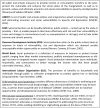Resourcing resilience: social protection for HIV prevention amongst children and adolescents in Eastern and Southern Africa
- PMID: 27399042
- PMCID: PMC5558245
- DOI: 10.2989/16085906.2016.1194299
Resourcing resilience: social protection for HIV prevention amongst children and adolescents in Eastern and Southern Africa
Erratum in
-
Corrigendum.Afr J AIDS Res. 2016 Sep;15(3):314. doi: 10.2989/16085906.2016.1221543. Epub 2016 Aug 17. Afr J AIDS Res. 2016. PMID: 27532800 No abstract available.
Abstract
Adolescents are the only age group with growing AIDS-related morbidity and mortality in Eastern and Southern Africa, making HIV prevention research among this population an urgent priority. Structural deprivations are key drivers of adolescent HIV infection in this region. Biomedical interventions must be combined with behavioural and social interventions to alleviate the socio-structural determinants of HIV infection. There is growing evidence that social protection has the potential to reduce the risk of HIV infection among children and adolescents. This research combined expert consultations with a rigorous review of academic and policy literature on the effectiveness of social protection for HIV prevention among children and adolescents, including prevention for those already HIV-positive. The study had three goals: (i) assess the evidence on the effectiveness of social protection for HIV prevention, (ii) consider key challenges to implementing social protection programmes that promote HIV prevention, and (iii) identify critical research gaps in social protection and HIV prevention, in Eastern and Southern Africa. Causal pathways of inequality, poverty, gender and HIV risk require flexible and responsive social protection mechanisms. Results confirmed that HIV-inclusive child-and adolescent-sensitive social protection has the potential to interrupt risk pathways to HIV infection and foster resilience. In particular, empirical evidence (literature and expert feedback) detailed the effectiveness of combination social protection particularly cash/in-kind components combined with "care" and "capability" among children and adolescents. Social protection programmes should be dynamic and flexible, and consider age, gender, HIV-related stigma, and context, including cultural norms, which offer opportunities to improve programmatic coverage, reach and uptake. Effective HIV prevention also requires integrated social protection policies, developed through strong national government ownership and leadership. Future research should explore which combinations of social protection work for sub-groups of children and adolescents, particularly those living with HIV.
Keywords: HIV/AIDS; care and support; cash; social protection.
Figures
Erratum for
-
Corrigendum.Afr J AIDS Res. 2016 Sep;15(3):314. doi: 10.2989/16085906.2016.1221543. Epub 2016 Aug 17. Afr J AIDS Res. 2016. PMID: 27532800 No abstract available.
Similar articles
-
Tackling gender inequalities and intimate partner violence in the response to HIV: moving towards effective interventions in Southern and Eastern Africa.Afr J AIDS Res. 2016 Jul;15(2):141-8. doi: 10.2989/16085906.2016.1204331. Afr J AIDS Res. 2016. PMID: 27399043
-
Structural drivers and social protection: mechanisms of HIV risk and HIV prevention for South African adolescents.J Int AIDS Soc. 2016 Apr 15;19(1):20646. doi: 10.7448/IAS.19.1.20646. eCollection 2016. J Int AIDS Soc. 2016. PMID: 27086838 Free PMC article.
-
Pre-exposure prophylaxis for HIV prevention in East and Southern Africa.Can J Public Health. 2018 Jan 22;108(5-6):e643-e645. doi: 10.17269/cjph.108.6254. Can J Public Health. 2018. PMID: 29356678 Free PMC article.
-
Funding of community-based interventions for HIV prevention.Afr J AIDS Res. 2016 Jul;15(2):163-71. doi: 10.2989/16085906.2016.1194300. Afr J AIDS Res. 2016. PMID: 27399046 Review.
-
Systematic review of cash plus or bundled interventions targeting adolescents in Africa to reduce HIV risk.BMC Public Health. 2024 Jan 20;24(1):239. doi: 10.1186/s12889-023-17565-9. BMC Public Health. 2024. PMID: 38245689 Free PMC article.
Cited by
-
The development of children born to young mothers with no, first- or second-generation HIV acquisition in the Eastern Cape province, South Africa: a cross-sectional study.BMJ Open. 2022 Oct 13;12(10):e058340. doi: 10.1136/bmjopen-2021-058340. BMJ Open. 2022. PMID: 36229140 Free PMC article.
-
Building resilience: a mental health intervention for Tanzanian youth living with HIV.AIDS Care. 2018;30(sup4):12-20. doi: 10.1080/09540121.2018.1527008. Epub 2019 Jan 9. AIDS Care. 2018. PMID: 30626197 Free PMC article. Clinical Trial.
-
Perceived impact of the COVID-19 pandemic and government restrictions on the lives of young adults living with HIV in Kisumu, Kenya.PLOS Glob Public Health. 2024 Dec 13;4(12):e0004064. doi: 10.1371/journal.pgph.0004064. eCollection 2024. PLOS Glob Public Health. 2024. PMID: 39671353 Free PMC article.
-
Consistent Provisions Mitigate Exposure to Sexual Risk and HIV Among Young Adolescents in South Africa.AIDS Behav. 2020 Mar;24(3):903-913. doi: 10.1007/s10461-019-02735-x. AIDS Behav. 2020. PMID: 31748938 Free PMC article.
-
Adolescents living with HIV, complex needs and resilience in Blantyre, Malawi.AIDS Res Ther. 2020 Jun 22;17(1):35. doi: 10.1186/s12981-020-00292-1. AIDS Res Ther. 2020. PMID: 32571375 Free PMC article.
References
-
- Adato M, Bassett L. Social protection to support vulnerable children and families: The potential of cash transfers to protect education, health and nutritionAIDS Care. 2009;21(sup1):60–75. http://doi.org/10.1080/09540120903112351. - DOI - PMC - PubMed
-
- Amzel A, Toska E, Lovich R, Widyono M, Patel T, Foti C, Altschuler J. Promoting a combination approach to paediatric HIV psychosocial supportAIDS (London, England) 2013;27(Suppl 2):S147–57. http://doi.org/10.1097/QAD.0000000000000098. - DOI - PMC - PubMed
-
- Baird SJ, Garfein RS, McIntosh CT, Ozler B. Effect of a cash transfer programme for schooling on prevalence of HIV and herpes simplex type 2 in Malawi: a cluster randomised trial. Lancet. 2012;379(9823):1320–9. http://doi.org/10.1016/S0140-6736(11)61709-1. - DOI - PubMed
-
- Bandiera O, Buehren N, Burgess R, Goldstein M, Gulesci S. Empowering Adolescent Girls: Evidence from a Randomized Control Trial in Uganda. London, United Kingdom: 2013. Retrieved from https://reach3.cern.ch/imagery/SSD/32BHP_Brace/Handover Lis/Resources/Me....
-
- Betancourt TS, Meyers-Ohki SE, Charrow A, Hansen N. Annual Research Review: Mental health and resilience in HIV/AIDS-affected children - a review of the literature and recommendations for future research. The Journal of Child Psychology and Psychiatry. 2013;54(4):423–44. http://doi.org/10.1111/j.1469-7610.2012.02613.x. - DOI - PMC - PubMed
Publication types
MeSH terms
Grants and funding
LinkOut - more resources
Full Text Sources
Other Literature Sources
Medical


